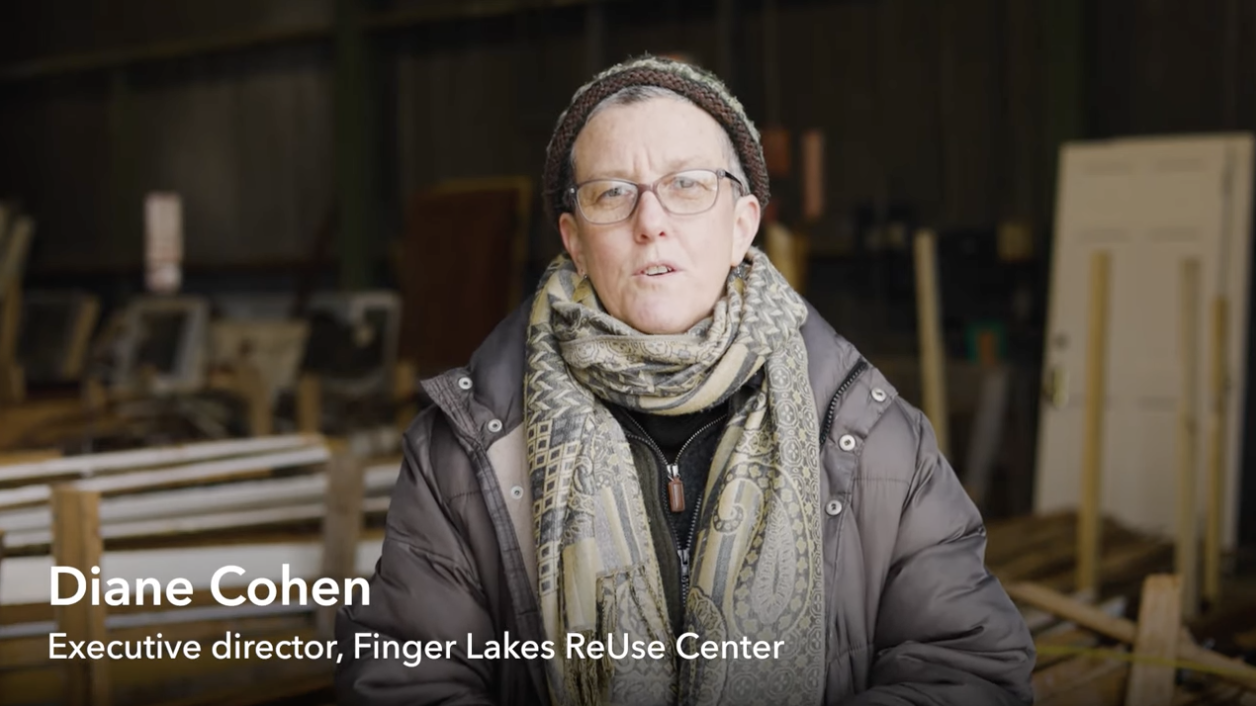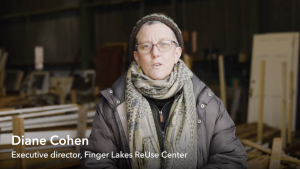
In a video made with Cornell University, Ithaca Rotarian Diane Cohen talks about deconstructing a house, reusing as much as possible, and designing houses and jobs to make construction zero-waste in the future.
By Jeff Smith, District Environmental Chair and PDG, D 7170
The Circular Economy is one of the six strategies charted on the ESRAG website under “themes.” All six combine to build a holistic approach to environmental sustainability. We focus on each twice a year to explain its importance and share news of effective projects Rotary clubs and districts are carrying out under that theme. For August, 2023, we’re sharing ways Rotarians discover paths to circular economy.
Definition of the Circular Economy:
The Ellen MacArthur Foundation provides the following definition: “The circular economy tackles climate change and other global challenges like biodiversity loss, waste, and pollution, by decoupling economic activity from the consumption of finite resources.”
The circular economy is based on three principles, driven by design:
- Eliminate waste and pollution
- Circulate products and materials (at their highest value)
- Regenerate nature
Underpinned by a transition to renewable energy and materials, the circular economy is a resilient system that is good for business, people, and the environment. In our current, linear economy, we take materials from the Earth, make products from them, and eventually throw them away as waste In a circular economy, by contrast, we prevent waste from being produced in the first place.
The ESRAG website highlights the following actions: Rethink, Refuse, Reduce, Re-choose, Repair, Reuse, Recycle towards zero waste. The principles of the circular economy are also described by leading writers on the climate challenge including Bill Gates in his book, How to Avoid a Climate Disaster: The Solutions We Have and the Breakthroughs We Need. Some circular economy challenges are very significant and require further research and development. For example, solutions for achieving net zero waste for concrete and steel are not readily available. On the other hand, there are many initiatives that districts and clubs can consider today.
A case study in challenge and opportunity:
The greatest challenge to pursuing strategies for the circular economy – and all facets of environmental sustainability – is finding the necessary resources. The economy of the region where I live, the Southern Tier of New York State, has been declining for decades primarily due to the decline of manufacturing. We have enormous opportunities to revive our economy by addressing two major labor needs. The first is to develop the workforce for jobs in solar and wind generation, storage, reuse, electrification, electric vehicles, infrastructure, controls, heat pumps and much more. Second, we have significant opportunities in advanced manufacturing to produce the necessary technology.
Many organizations are working together to develop our regional Clean Energy Career Summit for September 27. Some of the challenges include:
- Provide clean energy opportunities to underserved communities
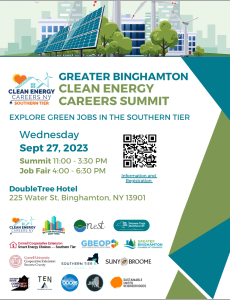
- Increase the retention rate of high school and college graduates in our region
- Strengthen the STEM/STEAM programs throughout the region
- Address barriers to employment including inadequate public transportation, day care, bias in the workforce, poverty, substance abuse, and criminal records
- Prepare immigrants and refugees for green careers
- Create “magnet communities” that can attract and retain the necessary resources.
Rotary’s holistic strategy must also address securing and training the resources that are required to do the work.
Circular Economy Projects that Districts and Clubs Can Consider:
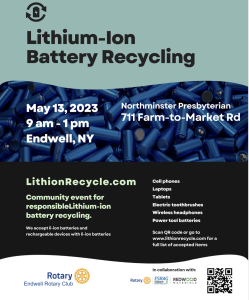
A lithium-ion battery recycling event organized by Endwell Rotary
Lithium-Ion Battery Recycling: Endwell Rotary Club is part of ESRAG’s collaboration with Redwood Industries. If your club is in the United States, you can use this toolkit to show your community how to recover the wealth of strategic metals in their garages and junk drawers, including cellphones, electric tools, and toothbrushes. Sign up here to host lithium-ion battery recycling events.
This is a wonderful alternative to the terrible impacts of mining and our dependence on foreign sources of lithium and cobalt. “Batteries can be infinitely recycled with 95% of the metals recovered to build the next generation of EVs and energy storage,” Redwood explains in this video.
Partnerships with other service clubs and community groups: We’re building on the trust and friendship our clubs have built over years of community service to promote circular economy, starting with ecosystem restoration. Upstream from Broome County is Cooperstown New York, site of the headwaters to the Susquehanna River. The Lions and Rotary Club have been partnering with community organizations to 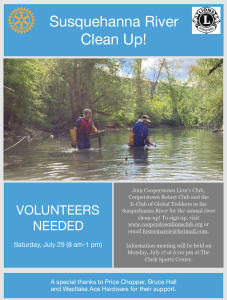 clean their part of the river. On July 29, we held our sixth annual clean-up. This event includes a team of divers and rafts to retrieve and remove tires, lumber, appliances and other waste materials found in the river. This track record has made us a natural partner in collaborations to address topics from invasive species to the development of a Nationally Ranked Water Trail that would span 190 miles from Cooperstown to the Finger Lakes region.
clean their part of the river. On July 29, we held our sixth annual clean-up. This event includes a team of divers and rafts to retrieve and remove tires, lumber, appliances and other waste materials found in the river. This track record has made us a natural partner in collaborations to address topics from invasive species to the development of a Nationally Ranked Water Trail that would span 190 miles from Cooperstown to the Finger Lakes region.
Rotarians are also teaming up with local government. One long-standing project of the Broome County Environmental Management Council (EMC) has been the annual river bank clean-up. Typically, 200 volunteers – including members of five different Rotary clubs – are recruited to address 20 sections of our river banks.
Today EMC is adding resources as the County gets more involved in the planning and organization to address environmental concerns and the climate challenge. Rotary has been asked to participate on projects including the team working to promote net zero waste. Some employees of Broome County are on the email lists for the Rotary District Committee on Environmental Sustainability, as well as our technical partner Tier Energy Network.
Finger Lakes ReUse: In 2008 Finger Lakes ReUse opened up in Ithaca, NY with an investment of just $700. Today the budget exceeds $2 million and used materials are a local resource, showing a better path than sending tons of building materials, computers, electronics, household goods, appliances, and furniture to the landfill unnecessarily. The Executive Director is Rotarian Diane Cohen. Finger Lakes ReUse taps the value of used materials to strengthen our economy, build community, and protect our environment by re-directing materials from the waste stream into productive new uses.
Finger Lakes ReUse operates a community-oriented warehouse, shopping, and educational center where the maximum reuse of materials is a priority; where safety, cleanliness, customer service, good business, education, and creativity are stressed; where living wage jobs are created and supported; where mentoring opportunities are available; and where education in the skills of repair and reuse is offered. Their aim is for everyone in the community to enjoy and partake in the services offered by Finger Lakes ReUse and, in time, to also assist other communities in the region to develop reuse services.
Diane Cohen, a member of Ithaca Rotary, is featured in this video by Cornell University and Finger Lakes ReUse showing the de-construction of an entire home with the goal of reusing as much of it as possible. A District Governor participated in this work crew.
In future issues we will showcase other projects supporting the Circular Economy around the world. Each month Rotary is strengthening its actions and partnerships on environmental sustainability. Rotary’s long-standing relationship with our communities and regions has built the trust and relationships to help Rotarians pursue strategies on environmental sustainability and to establish the necessary partnerships to make a difference.
